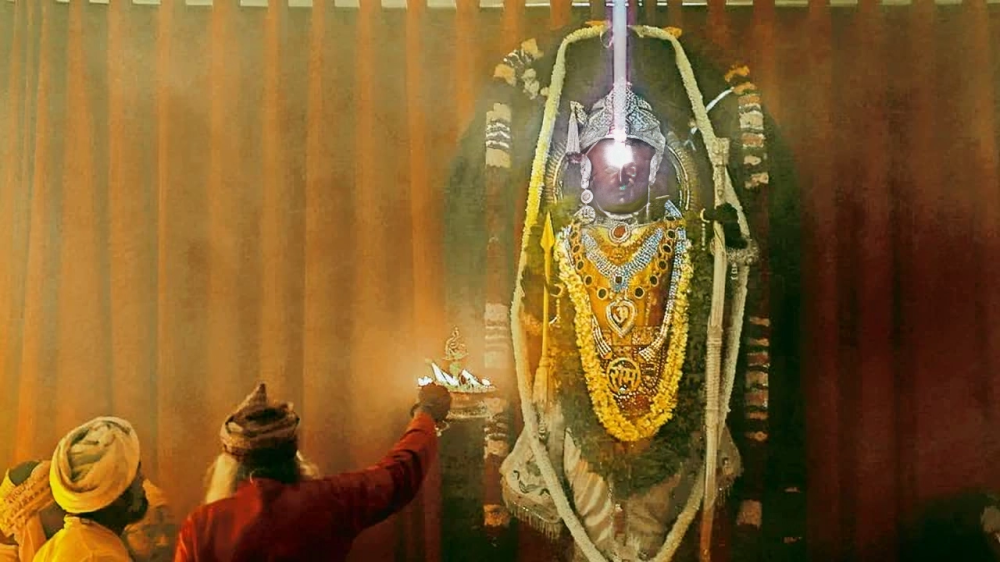On Wednesday, a multitude of individuals congregated in Ayodhya to commemorate the first Ram Navami since the inauguration of the Ram Temple on January 22nd of this year. They eagerly observed the “Surya Tilak,” a six-minute adornment of the forehead of the Ram Lalla idol with sun rays at noon.
According to officials, the radiant sun rays that illuminated the forehead of the Lord Ram Lalla idol at the newly constructed temple filled numerous devotees with euphoria. A statement released by the UP government stated, “Devotees present at the temple were completely absorbed in capturing this enchanting and unforgettable moment. Likewise, those who watched the event on large LED screens or from the comfort of their homes were equally enthralled.”
The statement further mentioned, “On this propitious occasion of Ram Navami, Ayodhya was adorned not only with the Janmabhoomi temple but also the entire city… This signifies the first ‘janmotsav’ (birth celebration) of Shri Ram Lalla at his birthplace after a struggle that spanned five centuries.”

The scientists have finally achieved success, and as per the planned schedule, a 75-mm sun ray tilak appeared on Ram Lalla’s forehead,” stated a spokesperson from the government.
The system has been devised in such a manner that sunlight from the outside is reflected to create a “tilak” shape on the idol’s forehead. Due to the temple still being under construction, the entire setup was not utilized on Wednesday.
Since the temple is not yet fully constructed, the experts from IIA (Indian Institute of Astrophysics) adjusted the design to fit the current structure and conducted image optimization. This particular design, consisting of four mirrors and two lenses, was implemented… The final version of the Surya Tilak, featuring four mirrors and four lenses, will be implemented once the temple construction is completed,” mentioned Prof Abhay Karandikar, the secretary of the Department of Science and Technology.
The Surya Tilak ritual will be performed annually on the occasion of Ram Navami.
The IIA, based in Bengaluru, assisted in refining the calculations that enable the system to accurately position the beam on the idol. Prof Karandikar elaborated: “Elaborate calculations indicate that the English calendar date of Sri Ram Navami repeats every 19 years. Determining the Sun’s position on these days requires expertise in astronomy.”
The initial mirror in the apparatus, M1, must be adjusted annually to align with the Sun’s position in order to project the Surya Tilak for six minutes. The complete projection will capture light from the third floor and reflect the tilak onto the idol inside. However, this year, the mechanism captured sunlight from the second floor.

Champat Rai, the general secretary of Shri Ram Janmabhoomi Teerth Kshetra, along with temple officials, has been overseeing all the preparations in the past few days. “On the auspicious occasion of Ram Navami, Ram Lalla was ceremoniously bathed and adorned in new festive attire that was specially prepared. With a large crowd of devotees expected, special arrangements were made. The atmosphere became vibrant with joyous devotees as the Mahamastakabhisheka took place precisely at the birth time, followed by the completion of the aarti amidst cheers,” stated a spokesperson.
The statement further mentioned that devotees were offered specially prepared ‘dhaniya ki panjiri’ (coriander panjiri) and other prasad as they left. “A chhappan bhog was also presented to Shri Ram Lalla, with these delicacies prepared at Karsevakpuram,” added the spokesperson. People also tuned in to watch the live telecast of the ‘janmotsav,’ including the Mahamastakabhishek under the sun rays, which was broadcasted on LED screens placed at various locations.
To ensure the smooth execution of the festivities, the district and police administration implemented comprehensive security measures. “The grand ‘janmotsav’ celebrations were also observed with great enthusiasm at major maths and temples across Ayodhya, including Ashrafi Bhawan, Shri Ram Ballabha Kunj, Dashrath Mahal, and Lakshman Fort,” stated an official.
“To handle the expected influx of visitors, Ayodhya was divided into 10 sectors,” the official added.
The official confirmed that the zonal magistrates, sector magistrates, and static magistrates assigned to the fair area were diligently carrying out their duties in collaboration with their respective police officers.
Throughout the last nine days, amenities such as clean water, medical camps, mobile toilets, and permanent toilets have been operational at different sites. The Municipal Corporation has organized sanitation workers to work in shifts 24/7 to ensure cleanliness.
A significant number of buses, including electric ones, have been provided by the district administration to facilitate the transportation of devotees to their destinations. Furthermore, the Railways has made appropriate arrangements for passenger transportation.

